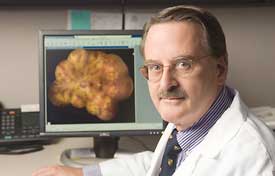Patients with a rare, blinding eye disease saw their vision improve after treatment with drugs to suppress their immune systems, according to researchers at the Kellogg Eye Center.
Because autoimmune retinopathy (AIR) is difficult to diagnose, the biggest challenge now is to find biologic markers that identify patients who can benefit from treatment.

In a review of 30 patients with autoimmune retinopathy, 21 individuals showed improvement after receiving treatment with immunosuppression therapy. The study, reported in the April issue of Archives of Ophthalmology, is the largest review of AIR cases to date. Improvement was defined by several measures, including the ability to read a minimum of two additional lines on the standard eye chart or expansion of at least 25 percent in visual field size.
“The results challenge the commonly held belief that autoimmune retinopathy is untreatable,” says Dr. John Heckenlively, author of the report and an international expert on retinal dystrophies.
In this disease, antibodies attack the retina, resulting in progressive vision loss and eventual blindness. AIR is like other autoimmune diseases in which the immune system goes awry and begins to attack healthy tissue. The patients in the current study were treated with various combinations of immunosuppression medications to counteract the unwanted autoantibodies from the immune system.
“It is not easy to identify patients with AIR because the clinical symptoms are very similar to other diseases involving retinal degeneration,” Heckenlively says. Typically these patients are diagnosed as having retinitis pigmentosa, a blinding eye disease for which there is no treatment.
“When someone asks how to distinguish one group from the other,” Heckenlively says, the answer often is “with difficulty.”
“We do not yet have a single test to confirm a diagnosis of AIR,” Heckenlively says. “However most patients have characteristic symptoms and findings, as well as subtle abnormalities on electrophysiologic testing. All patients have anti-retinal antibodies on blood testing, but that finding alone is not diagnostic. The majority of cases have other family members with autoimmune disorders. A clear diagnosis of AIR relies on carefully weighing all these factors.”
Heckenlively observes that few reports on AIR treatment are available in scientific publications, due largely to the difficulty in establishing the diagnosis.
“It is also possible that many patients are undertreated because we do not have good markers to evaluate treatment effects,” he says. “Now that we have evidence that immunosuppressant therapies work, we need further studies to evaluate which medications will be effective in treating autoimmune retinopathy.”
This work was supported in part by Foundation Fighting Blindness.
Additional U-M authors include Dr. Henry Ferreyra, Dr. Thiran Jayasundera, Naheed Khan, Shirley He and Ying Lu.

